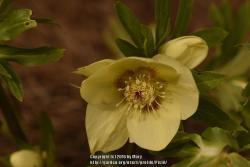The problem is, the word "hybrid" is used in more than one way.
In classic botany that I learned in college, a "hybrid" corn for example, was created by making two very pure strains of corn that are genetically very uniform, then crossing large numbers of them (one strain is mom, one is dad) to make a field full of offspring seeds, with hybrid vigor. This is the F1 Hybrid seed that you buy. The plants you grow from them are very uniform in terms of growth rate, size, flavor, and disease resistance. If you save seed from these, the offspring (F2 generation) exhibits a lot of variability, which the farmer does not want. It does not "come true to seed". Think Gregor Mendel.
"Hybrid" also means a cross between two species. For example Viburnum xburkwoodii is a hybrid between V. carlessii and V. utile. People have made this cross multiple times, so we have cultivars like 'Mohawk', and 'Chenault' and 'Conoy'. The x in the new name is an alert that this was made by crossing two species. If you save seeds from 'Mohawk' the offspring will be variable (Assuming it is fertile, some hybrids like Mules are not). Sometimes there are inter-generic crosses. These are then named with a contraction of the two genus names, with the x in front of this, like xFatshedera . However the fact of inter-genus mating may cause the taxonomists to question the accepted taxonomy. This happened with xDigiplexis, where they decided the Isoplexis canariensis was really a Digitalis! This one was bred by a Botanist at Thompson and Morgan Seed company, he tried for years before he got any fertile offspring from his crosses. Anyway these crosses could be done by you, and you could indeed produce your own Viburnum xburkwoodii by crossing a V. carlesii and V. utile. It would be called V xburkwoodii, but would NOT be 'Mohawk'. And you could not take seed from a 'Mohawk' and call the offspring 'Mohawk'. To make another 'Mohawk' you need to use vegetative reproduction like grafting, layering, cuttings or even now micropropagation.
"Cultivar" simply means a CULTIvated VARiety. It could be a plant that volunteered in someones garden or that was bred on purpose. There are some that do "come true from seed" because the breeder produced a pure strain, with little genetic variability. To keep it up and keep the strain nice requires some fancy care, and careful "roguing out" of any rogue plant in the seed field that is not true to type, before it can make seed. The strain should be called "open pollinated" if hand pollination was not done. Often without careful roguing, the plants will gradually revert to the regular species, like your Nigella. Heuchera 'Firefly' is a seed strain. Other cultivars must be propagated vegetatively to stay true to type, like Heuchera 'Caramel'. Your Salvia 'Blue Queen' is sold as a seed. If you collect seed from it you cannot call it 'Blue Queen', but the offspring will likely be similar. Some might be much taller, or a different color.
Now the word "hybrid' gets murkier. Some people use the word "hybridizer" to mean "breeder", or "hybrid" to mean a "cultivar". I might "breed" Collies, trying to get a better strain of Collies, but I am not a Collie "hybridizer".
Anyway, you can have a lot of fun sprouting the seeds of your named garden plants, but to have a named cultivar you do have to use vegetative methods of propagation, like division. I have found doing a little google search will often give me the info I need to guess at what the offspring might be of a plant in my garden. It's a lot of fun to save seed.
An example, Hellebores. The whole taxonomy of Hellebores is now complicated. They used to call the usual ones H. orientalis, but then decided they were too mixed up from people hybridizing (and breeding) dozens of species, so now they call them Helleborus xhybridus, to alert us that they are not pure species anymore.
The O'Byrnes in Oregon breed Hellebores, their nursery sells their 'Winter Jewels' strains, and you can buy plants or seeds. These are stabilized seed strains, so there is some variability of the plants. I have a bunch of yellow ones called 'Golden Sunrise'. they have different amounts of maroon speckles, but I like that. I could probably save seed and get yellow offspring (only if I put net bags around the flower buds and then hand pollinated them, as I have other Hellebores nearby). But I could not call them 'Golden Sunrise'.
Other named Hellebores are "one-offs", every plant the same having been propagated vegetatively from a single plant.
This does not even get into PP, PPAF, and Trademarked (TM) names. Or if seed-grown plants may or may not have stronger constitutions.
So far there does not seem to be any standardized way of alerting seed traders here on the seed swaps, as to what you are offering when it is seed from a named parent. I have resorted to saying the name of the mother cultivar, then putting an O.P. (for open pollinated) to alert folks of what they are getting. Does anyone have any better idea?
Well, I hope this helps. It really is complicated!

